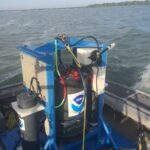The American Meteorological Society’s Annual Meeting (AMS 2017) is upon us and researchers from GLERL and CILER (the Cooperative Institute for Limnology and Ecosystems Research), along with other partners, are hitting the grounds running on Monday with posters and presentations on climate, … Continue reading
Category Archives: Communication

January 11, 2017
by Nicole Rice
1 Comment
Ice cover on the Great Lakes
Understanding the major effect of ice on the Great Lakes is very important because ice cover impacts a range of benefits provided by the lakes—from hydropower generation to commercial shipping to the fishing industry. Continue reading
December 14, 2016
by Kaye LaFond
2 Comments
Vertical Water Temperature in Southern Lake Michigan
Since 1990, GLERL scientists have been measuring temperature in the middle of southern Lake Michigan (at approximately 42.68, -87.07). They’ve been using a vertical chain of instruments that measure temperature from top to bottom. This is one of the longest vertical temperature … Continue reading

December 2, 2016
by Nicole Rice
1 Comment
Collaborative team identifies 16 high-risk Great Lakes invaders
NOAA’s Great Lakes Environmental Research Laboratory (GLERL) recently published a very detailed NOAA Technical Memorandum (GLERL-169), which identifies the potential for introduction (getting in), establishment (living and reproducing), and impact (changing the ecosystem in one way or another) of 67 species … Continue reading

November 21, 2016
by GLERL Communications Team
Comments Off on Working to improve Great Lakes modeling
Working to improve Great Lakes modeling
Water and atmospheric processes are inseparable. Now, there is a supercomputer model that couples climate and hydrodynamic factors for the Great Lakes region. Continue reading

October 14, 2016
by sonia joshi
3 Comments
Using Airplanes for Algal Bloom Prediction in Lake Erie
How can airplanes help predict harmful algal blooms (HABs)? For several years the National Oceanic and Atmospheric Administration (NOAA) has been using satellites to guide HAB forecasts. But, satellites have their limitations. For example, the Great Lakes region can be … Continue reading
October 4, 2016
by Nicole Rice
1 Comment
Retrieval of new data from instruments in Manistique River will inform research and decision making
During recent fieldwork, Dr. Philip Chu, scientist at NOAA’s Great Lakes Environmental Research Laboratory (GLERL) and Professor Chin Wu, from the University of Wisconsin Madison, retrieved six water level sensors and one Acoustic Doppler Current Profiler (ADCP) from the Manistique River—a … Continue reading
Analyzing Algal Toxins in Near Real-Time
This morning, along side our partners at the University of Michigan’s Cooperative Institute for Limnology and Ecosystems Research (CILER), we deployed the very first Environmental Sample Processor (ESP) in a freshwater system. An ESP is an autonomous robotic instrument that works as a … Continue reading
August 18, 2016
by Kaye LaFond
1 Comment
Tracking Changes in Great Lakes Temperature and Ice: New Approaches
In a new study, scientists from GLERL, the University of Michigan, and other institutions take a new look at changing ice cover and surface water temperature in the Great Lakes. The paper, set to be published in Climatic Change, is novel in two … Continue reading
August 9, 2016
by Kaye LaFond
Comments Off on UPDATE: GLERL Releases Drifter Buoys into Lake Erie
UPDATE: GLERL Releases Drifter Buoys into Lake Erie
Update 08/09/2016: The buoys have drifted ashore and are being collected! The map below shows their full journey. Original post 07/13/2016: Last week, GLERL scientists released two mobile buoys with GPS tracking capabilities, known as ‘Lagrangian drifters’, into Lake … Continue reading


